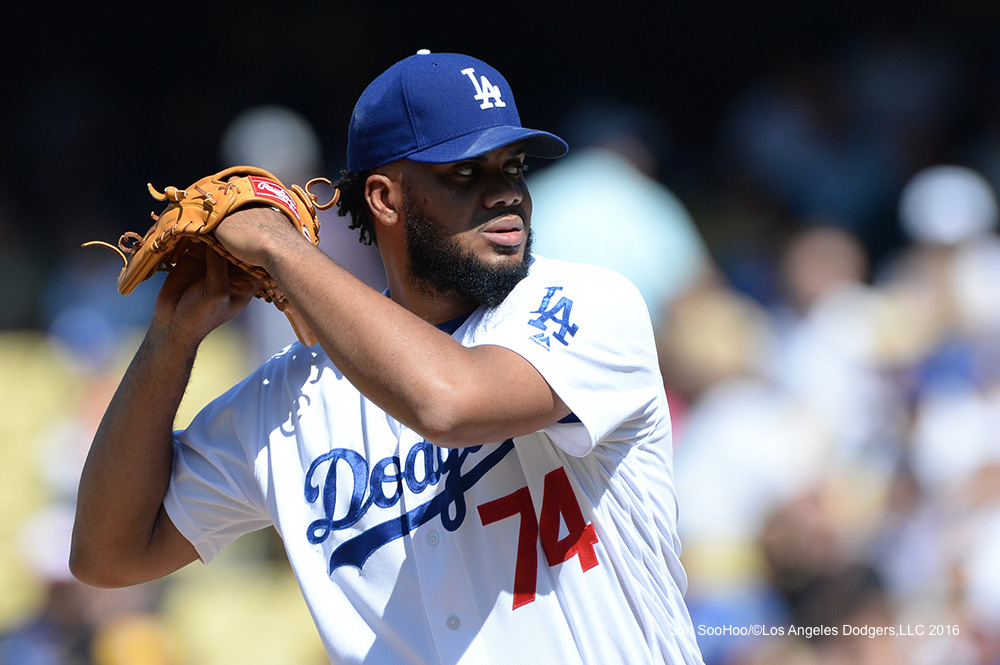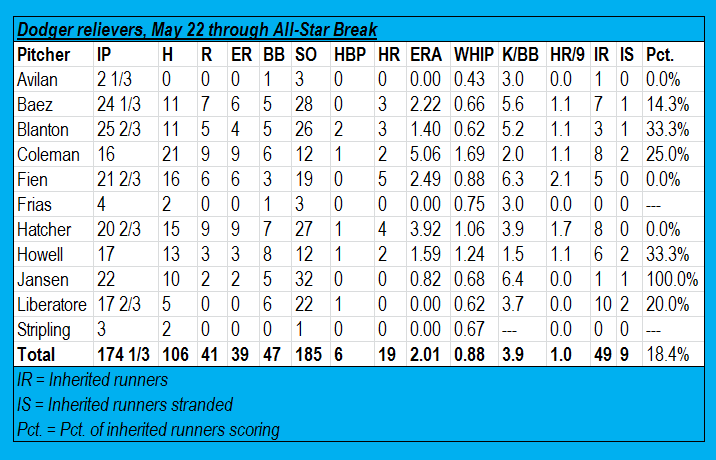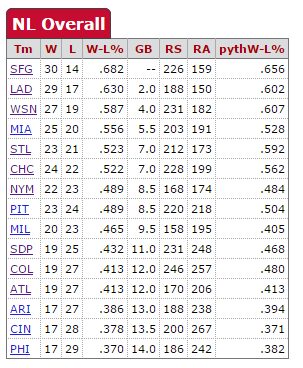By Jon Weisman
In the Dodgers’ final inning before the All-Star Break, the best closer in the National League, Kenley Jansen, entered the game to protect a one-run lead against the fourth-place team in the National League West.
At that moment, the Dodger bullpen was several weeks into an extended resurgence that was forcing fans and media alike to unlearn everything it thought it knew about the team’s relievers. It progressed in stages, as if reversing the five stages of grief.
- Hooray — they actually held a lead for once.
- All right, I’ve stopped throwing things every time a reliever comes in.
- I know this won’t last, but thank you for at least being adequate.
- Hmm. Some of these guys are actually pretty good.
- I don’t want to jinx this. But … wow.
Dodger bullpen failures have been branded into the collective memory of recent years, the scar tissue making it nearly impossible for most to feel the moments when the relievers were doing well — which, of course, was more often than the distraught and cynical could concede.
But by the time Jansen took the mound Sunday, the bullpen’s growing success was no longer possible to ignore.
Dodger relievers lead the Major Leagues with a 2.83 ERA. They lead the Major Leagues with a 1.02 WHIP.
In fact, as Dodger broadcaster Joe Davis pointed out, the Dodger bullpen’s opponents batting average of .192 is currently the lowest in modern baseball history. The team’s WHIP is the lowest in NL history.
That’s extraordinary. And that’s not wishcasting. That’s something that has been happening. The Dodger bullpen has become the opposite of an albatross. It’s a primary reason that, despite the “I Love Lucy” chocolate conveyor belt of injuries, that Los Angeles (51-40) is on a 91-win pace and once again a team to be reckoned with.
In terms of inherited runners stranded, the Dodgers were seventh among MLB teams at 72 percent — in the upper echelon but with room for improvement. The good news — the great news — is that the improvement is already underway.
The turnaround began May 22 at San Diego. The previous two nights, the Dodgers had suffered walkoff losses. At a time when the Dodger bullpen seemed vulnerable, the last line of defense — Jansen — faltered. Having allowed one run in the Dodgers’ first 42 games, Jansen on May 20 gave up the first walkoff homer of his seven-year career, Melvin Upton Jr. hitting the game-winning two-run blast.
The next night, Adam Liberatore allowed a tying run in the seventh inning. The game went into the 11th, and the Dodgers were forced to turn to a recent callup, Chin-hui Tsao, who walked in the winning run and then almost immediately joined the parade to the disabled list.
On May 22, the Dodgers blew a lead for the third straight game. For the second time in the series, Upton victimized Jansen, who had come in to try to save the beleaguered bullpen with a four-out save. Upton’s RBI triple not only tied the game, it effectively created a doubleheader — eight extra innings of baseball.
From the ninth inning to the 16th, the Dodgers did not score. But from the ninth inning to the 17th, Dodger relievers didn’t allow a run. Ultimately, it required the services of erstwhile starting pitcher Ross Stripling, but in that game, Dodger relievers pitched 12 innings and surrendered one run.
From May 22 on, here’s how the bullpen has performed:
Looking at the 2.01 ERA and WHIP, that’s 174 1/3 innings of Cy Young-worthy performance (in a world without Clayton Kershaw, at least).
In the process, the Dodger bullpen was also conquering that Achilles heel: inherited runners. By stranding 81.6 percent of runners on base when they entered the game, Dodger relievers matched the pace of the MLB leader in that category, Houston.
And so we turn to the standings. Since May 22, the Dodgers are 29-17 (.630), the third-best record in the Major Leagues and second in the NL. The only team in the league that’s been better: the Giants, who are 30-14. But the success has allowed the Dodgers stay in divisional contention behind the team with the best record in baseball, while building a 2 1/2-game cushion in the NL Wild Card race.
All this with a starting rotation’s worth of pitchers on the disabled list for some or all of those 46 games: Brett Anderson, Brandon McCarthy, Hyun-Jin Ryu, Alex Wood and, most notably, Kershaw.
Still, Dodger fans always need something to worry about, and in an ironic sense, the Dodger relievers obliged by doing so well. In its past 10 games alone, the bullpen threw 44 innings, with a 1.64 ERA, 0.77 WHIP and 10.6 K/9. Suddenly vital to the Dodgers’ cause, the concern became not whether Dodger relievers could do the job, but whether they were doing too much of it.
Here’s how things look with the eight relievers the Dodgers have relied upon the most:
 Chris Hatcher’s innings are higher this year because he has been used more as a long man, not to mention that he was on the disabled list last summer. Jansen is also within range of an acceptable increase, taking his 2015 stay on the disabled list into account. Their usage is something to monitor, though if anyone’s truly in need of a second-half rest, it might be Pedro Baez.
Chris Hatcher’s innings are higher this year because he has been used more as a long man, not to mention that he was on the disabled list last summer. Jansen is also within range of an acceptable increase, taking his 2015 stay on the disabled list into account. Their usage is something to monitor, though if anyone’s truly in need of a second-half rest, it might be Pedro Baez.
In any case, the Dodgers have several potential reinforcements they can turn to inside the organization (from the big-league disabled list or the minor leagues), as well as opportunities to acquired players on the trade market.
Nobody knows what will happen, just as nobody knew what would happen when Jansen entered that ninth inning in that last game before the All-Star Break. Then, Travis Janokowski hit a 94 mph Jansen cutter slowly to shortstop for an infield single. Then, Upton — Jansen’s 2016 nemesis — walked. Twelve pitches into the inning, Jansen had none out, with the tying and go-ahead runs on base.
Wil Myers, Matt Kemp and Yangervis Solarte — 43 homers between them — came up with the chance to crush the ball and crush the narrative.
With a cutter, Jansen struck out Myers. With a four-seam fastball, Jansen struck out Kemp. And on his 30th pitch of the inning, Jansen got Solarte to hit a harmless fly to left.
Jansen and the bullpen came through yet again. Yes, you could get used to this.








oldbrooklynfan
I’ll admit, I still get a little nervous when Jansen comes in, I think I always will be, but I am aware that the bullpen is carrying this team.
frednaz
Yes, the bullpen is good. No, I don’t think there is a setup guy yet that will make everybody relax when the Dodgers get into the playoffs. Kershaw goes 7 with a 2 – 1 lead, has thrown 114 pitches, needs to come out, who do the Dodgers use for that lock down 8th innings? Urias? Blanton? De Leon? Libatore? Garcia?
Don Bright
Right now it would be Libby against lefties, and Blanton against the righties. But frankly I think this is the one trade the FO explores heavily, getting a true 8th inning setup (and possible closer for next year).
Garcia probably is on DL rest of year.
David Young (@DavidYoungTBLA)
Jon, nicely presented article. I’ve been researching similar stuff. One nit: I believe you included minor league numbers in the 2015 numbers but not the first-half 2016 numbers, so that’s not quite an apples-to-apples comparison in some cases. That’s about a 20% increase in IP for Fien, for example. I think only Fien and Liberatore have non-LAD IP to consider.
Jon Weisman
I certainly intended to include minor-league innings for both years — if I missed one or two, it was an oversight. I specifically remember looking at Fien’s minor-league numbers for this year.